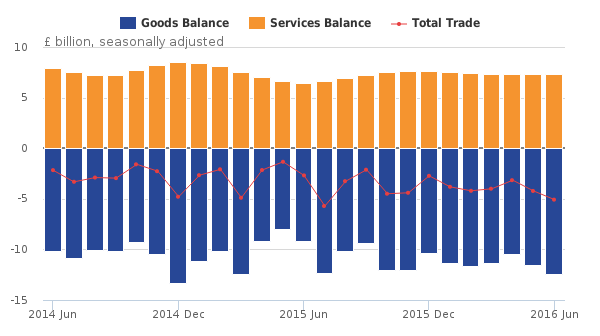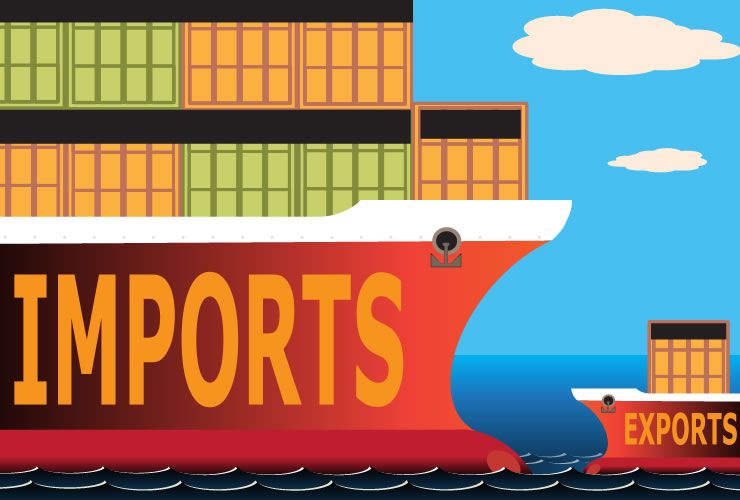As UK Trade Deficit Baloons the Government says it is Doing all it can on Providing Trade Finance
- Written by: Gary Howes
-
The ONS recently released trade figures for the month of June, showing a widened trade deficit, meaning the difference between imports and exports widened by around £900m since May 2016.
Import / export data are important indicators for economic health, and are a major contributor to the UK’s economic output.
Unfortunately, the UK is not doing very well on this front at present.
Research by Barclays reveals that the the UK’s trade performance has fallen short of its peers and can be explained by a steady erosion of export competitiveness since the 1960s, despite a string of large Sterling devaluations.
The performance of services has remained strong, but the exchange rate response is muted and does not make up for the deficit in goods.
The trend has been confirmed by the most recent figures from the ONS which show that the UK increased both the amount of goods and services it imported.
An uptick in exports was however also noted, however it was not enough to take us out of deficit.
The balance of trade is a calculation of total value of exports minus total value of imports, and because imports reached record high of £48.9bn, up +4% from May, and total exports increased to £43.8bn, up +2.5% from May.

The latest June figures showing the difference (in £ billion) in goods balance (-£12.4) and services balance (£7.3) which forms the UK Balance of Trade (-£5.1). Source: ONS
Owing to the huge (largely unexpected) increase in imports over the last month, the trade deficit widened by £0.9bn, to a total of £5.1bn.
This reflected a one year high (since July 2015), where the trade deficit was £5.7bn.
Why did Imports Surge?
Taking a deep dive into quarterly data (Quarter 2 2016 versus Quarter 1 2016), the picture is still similar; a larger increase in imports, offset by a small increase in exports.
In terms of trade in goods, machinery and transport equipment rose by £2.6bn, comprising a notable increase in road vehicles and aircraft. Oil and chemical imports increased by £0.5bn and £0.3bn respectively.
Trade in services were fairly stable and saw no notable changes in the last quarter. There was a small decrease in export of services (-£0.3bn) to £57.6bn and a £22m increase in imports for the same period, mainly due to an increase in travel services.
Looking into geographic areas, there was a large increase in goods from Germany, Belgium and Luxembourg. Outside of the EU, goods imported from China rose by £2.2bn, as well as imports from South Korea and Turkey.
Government Can Help
“The somewhat disappointing figures, despite the UK attempting to try and boost exports to rebalance the economy certainly show a need for the British Government to rethink and revise its new export strategy” said James Sinclair at Trade Finance Global.
Sinclair argues that to significantly move the needle on exports, the UK government should continue to increase accessibility and availability of credit for exporters, not only short term lending, but also longer term lending.
Duty drawback schemes are cited by Sinclair as an effective measure which allow businesses to claim drawback or refund custom duties which makes exporting more affordable.
However, UK Export Finance, the UK's export credit agency and a government department says they continue to aim to ensure that no viable UK exports are compromised by a lack of finance or insurance.
"In 2015-16, we supported more companies than at any point in the past 25 years, with a 23% increase on 2014-15. This shows that we are making significant progress in reaching a wider customer base. We will continue to be innovative and flexible, anticipating the needs of exporters and finding ways to meet them," Gordon Welsh, UK Export Finance's Head of Business Group told Pound Sterling Live.
It would seem then that the ability to act quickly, draw up creative financial solutions, and adapt to a changing export finance market is crucial for success for stimulating trade performance.
This also means trade export financiers need to work collaboratively with other finance providers such as insurers, FX brokers and factoring companies to ensure the entire supply chain is serviced to meet the expectations of those trading and exporting overseas.
Pound to do the Heavy Lifting
While the government and private finance can achieve much in aiding UK exports, ultimately it will be the macro-economic background that will really boost UK exports.
The recent interest rate cuts to boost spending and encourage borrowing, coupled with the depreciation of the pound sterling, largely as a result of the EU referendum is bound to help close this gap upon release of July’s trade figures, which will be the first tangible data reflecting the UK economy post Brexit.
This week’s decline took the slide in the trade-weighted sterling index to around 12% since the referendum, and that follows a substantial depreciation in the first half of the year.
This means that, altogether, the pound is down about 18% since last November.
"This would normally have a significant economic impact. It makes exports more competitive and, imports less so, while higher import prices would be expected to lift inflation," explains Adam Chester, Head of Economics, Commercial Banking at Lloyds Bank.
Looking across sectors, Chester says it is potentially positive for manufacturers, who tend to be big exporters, although at least some will also see their import costs go up.
It should also help some services industries such as tourism.
"From a cost point of view this is a good year to be taking a holiday in the UK, particularly if you are an American. In contrast, right now is a particularly expensive time for a Brit to holiday abroad," says Chester.




